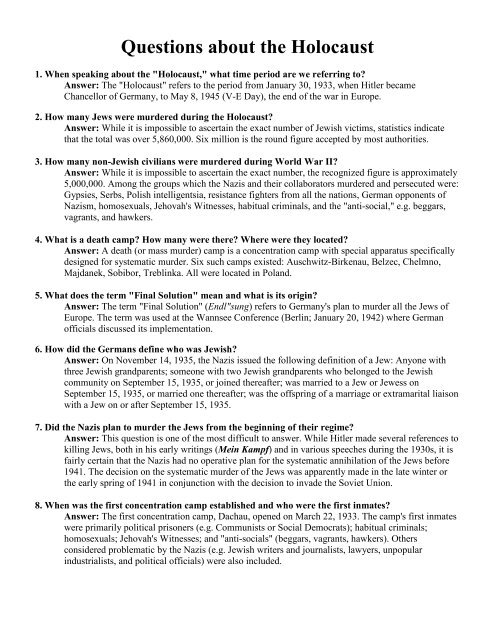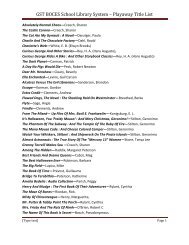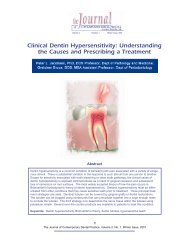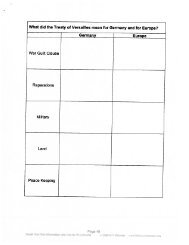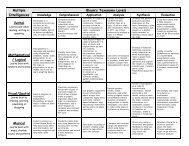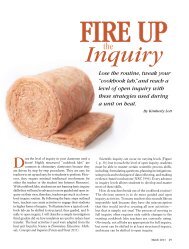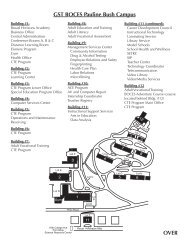Questions about the Holocaust - gst boces
Questions about the Holocaust - gst boces
Questions about the Holocaust - gst boces
You also want an ePaper? Increase the reach of your titles
YUMPU automatically turns print PDFs into web optimized ePapers that Google loves.
<strong>Questions</strong> <strong>about</strong> <strong>the</strong> <strong>Holocaust</strong><br />
1. When speaking <strong>about</strong> <strong>the</strong> "<strong>Holocaust</strong>," what time period are we referring to?<br />
Answer: The "<strong>Holocaust</strong>" refers to <strong>the</strong> period from January 30, 1933, when Hitler became<br />
Chancellor of Germany, to May 8, 1945 (V-E Day), <strong>the</strong> end of <strong>the</strong> war in Europe.<br />
2. How many Jews were murdered during <strong>the</strong> <strong>Holocaust</strong>?<br />
Answer: While it is impossible to ascertain <strong>the</strong> exact number of Jewish victims, statistics indicate<br />
that <strong>the</strong> total was over 5,860,000. Six million is <strong>the</strong> round figure accepted by most authorities.<br />
3. How many non-Jewish civilians were murdered during World War II?<br />
Answer: While it is impossible to ascertain <strong>the</strong> exact number, <strong>the</strong> recognized figure is approximately<br />
5,000,000. Among <strong>the</strong> groups which <strong>the</strong> Nazis and <strong>the</strong>ir collaborators murdered and persecuted were:<br />
Gypsies, Serbs, Polish intelligentsia, resistance fighters from all <strong>the</strong> nations, German opponents of<br />
Nazism, homosexuals, Jehovah's Witnesses, habitual criminals, and <strong>the</strong> "anti-social," e.g. beggars,<br />
vagrants, and hawkers.<br />
4. What is a death camp? How many were <strong>the</strong>re? Where were <strong>the</strong>y located?<br />
Answer: A death (or mass murder) camp is a concentration camp with special apparatus specifically<br />
designed for systematic murder. Six such camps existed: Auschwitz-Birkenau, Belzec, Chelmno,<br />
Majdanek, Sobibor, Treblinka. All were located in Poland.<br />
5. What does <strong>the</strong> term "Final Solution" mean and what is its origin?<br />
Answer: The term "Final Solution" (Endl"sung) refers to Germany's plan to murder all <strong>the</strong> Jews of<br />
Europe. The term was used at <strong>the</strong> Wannsee Conference (Berlin; January 20, 1942) where German<br />
officials discussed its implementation.<br />
6. How did <strong>the</strong> Germans define who was Jewish?<br />
Answer: On November 14, 1935, <strong>the</strong> Nazis issued <strong>the</strong> following definition of a Jew: Anyone with<br />
three Jewish grandparents; someone with two Jewish grandparents who belonged to <strong>the</strong> Jewish<br />
community on September 15, 1935, or joined <strong>the</strong>reafter; was married to a Jew or Jewess on<br />
September 15, 1935, or married one <strong>the</strong>reafter; was <strong>the</strong> offspring of a marriage or extramarital liaison<br />
with a Jew on or after September 15, 1935.<br />
7. Did <strong>the</strong> Nazis plan to murder <strong>the</strong> Jews from <strong>the</strong> beginning of <strong>the</strong>ir regime?<br />
Answer: This question is one of <strong>the</strong> most difficult to answer. While Hitler made several references to<br />
killing Jews, both in his early writings (Mein Kampf) and in various speeches during <strong>the</strong> 1930s, it is<br />
fairly certain that <strong>the</strong> Nazis had no operative plan for <strong>the</strong> systematic annihilation of <strong>the</strong> Jews before<br />
1941. The decision on <strong>the</strong> systematic murder of <strong>the</strong> Jews was apparently made in <strong>the</strong> late winter or<br />
<strong>the</strong> early spring of 1941 in conjunction with <strong>the</strong> decision to invade <strong>the</strong> Soviet Union.<br />
8. When was <strong>the</strong> first concentration camp established and who were <strong>the</strong> first inmates?<br />
Answer: The first concentration camp, Dachau, opened on March 22, 1933. The camp's first inmates<br />
were primarily political prisoners (e.g. Communists or Social Democrats); habitual criminals;<br />
homosexuals; Jehovah's Witnesses; and "anti-socials" (beggars, vagrants, hawkers). O<strong>the</strong>rs<br />
considered problematic by <strong>the</strong> Nazis (e.g. Jewish writers and journalists, lawyers, unpopular<br />
industrialists, and political officials) were also included.
9. Which groups of people in Germany were considered enemies of <strong>the</strong> state by <strong>the</strong> Nazis and were,<br />
<strong>the</strong>refore, persecuted?<br />
Answer: The following groups of individuals were considered enemies of <strong>the</strong> Third Reich and were,<br />
<strong>the</strong>refore, persecuted by <strong>the</strong> Nazi authorities: Jews, Gypsies, Social Democrats, o<strong>the</strong>r opposing<br />
politicians, opponents of Nazism, Jehovah's Witnesses, homosexuals, habitual criminals, and "antisocials"<br />
(e.g. beggars, vagrants, hawkers), and <strong>the</strong> mentally ill. Any individual who was considered a<br />
threat to <strong>the</strong> Nazis was in danger of being persecuted.<br />
10. What did people in Germany know <strong>about</strong> <strong>the</strong> persecution of Jews and o<strong>the</strong>r enemies of Nazism?<br />
Answer: Certain initial aspects of Nazi persecution of Jews and o<strong>the</strong>r opponents were common<br />
knowledge in Germany. Thus, for example, everyone knew <strong>about</strong> <strong>the</strong> Boycott of April 1, 1933, <strong>the</strong><br />
Laws of April, and <strong>the</strong> Nuremberg Laws, because <strong>the</strong>y were fully publicized. Moreover, offenders<br />
were often publicly punished and shamed. The same holds true for subsequent anti-Jewish measures.<br />
Kristallnacht (The Night of <strong>the</strong> Broken Glass) was a public pogrom, carried out in full view of <strong>the</strong><br />
entire population. While information on <strong>the</strong> concentration camps was not publicized, a great deal of<br />
information was available to <strong>the</strong> German public, and <strong>the</strong> treatment of <strong>the</strong> inmates was generally<br />
known, although exact details were not easily obtained.<br />
As for <strong>the</strong> implementation of <strong>the</strong> "Final Solution" and <strong>the</strong> murder of o<strong>the</strong>r undesirable elements, <strong>the</strong><br />
situation was different. The Nazis attempted to keep <strong>the</strong> murders a secret and, <strong>the</strong>refore, took<br />
precautionary measures to ensure that <strong>the</strong>y would not be publicized.<br />
11. Did all Germans support Hitler's plan for <strong>the</strong> persecution of <strong>the</strong> Jews?<br />
Answer: Although <strong>the</strong> entire German population was not in agreement with Hitler's persecution of<br />
<strong>the</strong> Jews, <strong>the</strong>re is no evidence of any large scale protest regarding <strong>the</strong>ir treatment.<br />
12. Did <strong>the</strong> people of occupied Europe know <strong>about</strong> Nazi plans for <strong>the</strong> Jews? What was <strong>the</strong>ir attitude?<br />
Did <strong>the</strong>y cooperate with <strong>the</strong> Nazis against <strong>the</strong> Jews?<br />
Answer: The attitude of <strong>the</strong> local population vis-a-vis <strong>the</strong> persecution and destruction of <strong>the</strong> Jews<br />
varied from zealous collaboration with <strong>the</strong> Nazis to active assistance to Jews. Thus, it is difficult to<br />
make generalizations. The situation also varied from country to country. In Eastern Europe and<br />
especially in Poland, Russia, and <strong>the</strong> Baltic States (Estonia, Latvia, and Lithuania), <strong>the</strong>re was much<br />
more knowledge of <strong>the</strong> "Final Solution" because it was implemented in those areas. Elsewhere, <strong>the</strong><br />
local population had less information on <strong>the</strong> details of <strong>the</strong> "Final Solution."<br />
13. Did <strong>the</strong> Allies and <strong>the</strong> people in <strong>the</strong> Free World know <strong>about</strong> <strong>the</strong> events going on in Europe?<br />
Answer: The various steps taken by <strong>the</strong> Nazis prior to <strong>the</strong> "Final Solution" were all taken publicly<br />
and were, <strong>the</strong>refore, reported in <strong>the</strong> press. Foreign correspondents commented on all <strong>the</strong> major anti-<br />
Jewish actions taken by <strong>the</strong> Nazis in Germany, Austria, and Czechoslovakia prior to World War II.<br />
Once <strong>the</strong> war began, obtaining information became more difficult, but reports, none<strong>the</strong>less, were<br />
published regarding <strong>the</strong> fate of <strong>the</strong> Jews. Thus, although <strong>the</strong> Nazis did not publicize <strong>the</strong> "Final<br />
Solution," less than one year after <strong>the</strong> systematic murder of <strong>the</strong> Jews was initiated, details began to<br />
filter out to <strong>the</strong> West. The first report which spoke of a plan for <strong>the</strong> mass murder of Jews was<br />
smuggled out of Poland by <strong>the</strong> Bund (a Jewish socialist political organization) and reached England<br />
in <strong>the</strong> spring of 1942. The details of this report reached <strong>the</strong> Allies from Vatican sources as well as<br />
from informants in Switzerland and <strong>the</strong> Polish underground. (Jan Karski, an emissary of <strong>the</strong> Polish<br />
underground, personally met with Franklin Roosevelt and British Foreign Minister Anthony Eden).<br />
Eventually, <strong>the</strong> American Government confirmed <strong>the</strong> reports to Jewish leaders in late November<br />
1942. They were publicized immediately <strong>the</strong>reafter. While <strong>the</strong> details were nei<strong>the</strong>r complete nor<br />
wholly accurate, <strong>the</strong> Allies were aware of most of what <strong>the</strong> Germans had done to <strong>the</strong> Jews at a<br />
relatively early date.
14. What was <strong>the</strong> response of <strong>the</strong> Allies to <strong>the</strong> persecution of <strong>the</strong> Jews? Could <strong>the</strong>y have done anything<br />
to help?<br />
Answer: The response of <strong>the</strong> Allies to <strong>the</strong> persecution and destruction of European Jewry was<br />
inadequate. Only in January 1944 was an agency, <strong>the</strong> War Refugee Board, established for <strong>the</strong> express<br />
purpose of saving <strong>the</strong> victims of Nazi persecution. Prior to that date, little action was taken. On<br />
December 17, 1942, <strong>the</strong> Allies issued a condemnation of Nazi atrocities against <strong>the</strong> Jews, but this was<br />
<strong>the</strong> only such declaration made prior to 1944.<br />
Moreover, no attempt was made to call upon <strong>the</strong> local population in Europe to refrain from assisting<br />
<strong>the</strong> Nazis in <strong>the</strong>ir systematic murder of <strong>the</strong> Jews. Even following <strong>the</strong> establishment of <strong>the</strong> War<br />
Refugee Board and <strong>the</strong> initiation of various rescue efforts, <strong>the</strong> Allies refused to bomb <strong>the</strong> death camp<br />
of Auschwitz and/or <strong>the</strong> railway lines leading to that camp, despite <strong>the</strong> fact that Allied bombers were<br />
at that time engaged in bombing factories very close to <strong>the</strong> camp and were well aware of its existence<br />
and function.<br />
15. Did <strong>the</strong> Jews in Europe realize what was going to happen to <strong>the</strong>m?<br />
Answer: Regarding <strong>the</strong> knowledge of <strong>the</strong> "Final Solution" by its potential victims, several key points<br />
must be kept in mind. First of all, <strong>the</strong> Nazis did not publicize <strong>the</strong> "Final Solution," nor did <strong>the</strong>y ever<br />
openly speak <strong>about</strong> it. Every attempt was made to fool <strong>the</strong> victims and, <strong>the</strong>reby, prevent or minimize<br />
resistance. Thus, deportees were always told that <strong>the</strong>y were going to be "resettled." They were led to<br />
believe that conditions "in <strong>the</strong> East" (where <strong>the</strong>y were being sent) would be better than those in<br />
ghettos. Following arrival in certain concentration camps, <strong>the</strong> inmates were forced to write home<br />
<strong>about</strong> <strong>the</strong> wonderful conditions in <strong>the</strong>ir new place of residence. The Germans made every effort to<br />
ensure secrecy.<br />
16. Did <strong>the</strong> Jews try to fight against <strong>the</strong> Nazis? To what extent were such efforts successful?<br />
Answer: Despite <strong>the</strong> difficult conditions to which Jews were subjected in Nazi-occupied Europe,<br />
many engaged in armed resistance against <strong>the</strong> Nazis. This resistance can be divided into three basic<br />
types of armed activities: ghetto revolts, resistance in concentration and death camps, and partisan<br />
warfare.<br />
The Warsaw Ghetto revolt, which lasted for <strong>about</strong> five weeks beginning on April 19, 1943, is<br />
probably <strong>the</strong> best-known example of armed Jewish resistance, but <strong>the</strong>re were many ghetto revolts in<br />
which Jews fought against <strong>the</strong> Nazis.<br />
Despite <strong>the</strong> terrible conditions in <strong>the</strong> death, concentration, and labor camps, Jewish inmates fought<br />
against <strong>the</strong> Nazis at <strong>the</strong> following sites: Treblinka (August 2, 1943); Babi Yar (September 29, 1943);<br />
Sobibór (October 14, 1943); Janówska (November 19, 1943); and Auschwitz (October 7, 1944).<br />
Jewish partisan units were active in many areas, including Baranovichi, Minsk, Naliboki forest, and<br />
Vilna. While <strong>the</strong> sum total of armed resistance efforts by Jews was not militarily overwhelming and<br />
did not play a significant role in <strong>the</strong> defeat of Nazi Germany, <strong>the</strong>se acts of resistance did lead to <strong>the</strong><br />
rescue of an undetermined number of Jews, Nazi casualties, and untold damage to German property<br />
and self-esteem.
17. What was <strong>the</strong> Judenrat?<br />
Answer: The Judenrat was <strong>the</strong> council of Jews, appointed by <strong>the</strong> Nazis in each Jewish community or<br />
ghetto. According to <strong>the</strong> directive from Reinhard Heydrich of <strong>the</strong> SS on September 21, 1939, a<br />
Judenrat was to be established in every concentration of Jews in <strong>the</strong> occupied areas of Poland. They<br />
were led by noted community leaders. Enforcement of Nazi decrees affecting Jews and<br />
administration of <strong>the</strong> affairs of <strong>the</strong> Jewish community were <strong>the</strong> responsibilities of <strong>the</strong> Judenrat. These<br />
functions placed <strong>the</strong> Judenrat in a highly responsible, but controversial position, and many of <strong>the</strong>ir<br />
actions continue to be <strong>the</strong> subject of debate among historians. While <strong>the</strong> intentions of <strong>the</strong> heads of<br />
councils were rarely challenged, <strong>the</strong>ir tactics and methods have been questioned. Among <strong>the</strong> most<br />
controversial were Mordechai Rumkowski in Lodz and Jacob Gens in Vilna, both of whom justified<br />
<strong>the</strong> sacrifice of some Jews in order to save o<strong>the</strong>rs. Leaders and members of <strong>the</strong> Judenrat were guided,<br />
for <strong>the</strong> most part, by a sense of communal responsibility, but lacked <strong>the</strong> power and <strong>the</strong> means to<br />
successfully thwart Nazi plans for annihilation of all Jews.<br />
18. How did Germany's allies, <strong>the</strong> Japanese and <strong>the</strong> Italians, treat <strong>the</strong> Jews in <strong>the</strong> lands <strong>the</strong>y occupied?<br />
Answer: Nei<strong>the</strong>r <strong>the</strong> Italians nor <strong>the</strong> Japanese, both of whom were Germany's allies during World<br />
War II, cooperated regarding <strong>the</strong> "Final Solution." Although <strong>the</strong> Italians did, upon German urging,<br />
institute discriminatory legislation against Italian Jews, Mussolini's government refused to participate<br />
in <strong>the</strong> "Final Solution" and consistently refused to deport its Jewish residents. Moreover, in <strong>the</strong>ir<br />
occupied areas of France, Greece, and Yugoslavia, <strong>the</strong> Italians protected <strong>the</strong> Jews and did not allow<br />
<strong>the</strong>m to be deported. However, when <strong>the</strong> Germans overthrew <strong>the</strong> Badoglio government in 1943, <strong>the</strong><br />
Jews of Italy, as well as those under Italian protection in occupied areas, were subject to <strong>the</strong> "Final<br />
Solution."<br />
19. What were <strong>the</strong> Nuremberg trials?<br />
Answer: The term "Nuremberg Trials" refers to two sets of trials of Nazi war criminals conducted<br />
after <strong>the</strong> war. The first trials were held November 20, 1945 to October 1, 1946, before <strong>the</strong><br />
International Military Tribunal (IMT), which was made up of representatives of France, Great<br />
Britain, <strong>the</strong> Soviet Union, and <strong>the</strong> United States. It consisted of <strong>the</strong> trials of <strong>the</strong> political, military and<br />
economic leaders of <strong>the</strong> Third Reich captured by <strong>the</strong> Allies. Among <strong>the</strong> defendants were: G"ring,<br />
Rosenberg, Streicher, Kaltenbrunner, Seyss-Inquart, Speer, Ribbentrop and Hess (many of <strong>the</strong> most<br />
prominent Nazis -- Hitler, Himmler, and Goebbels -- committed suicide and were not brought to<br />
trial). The second set of trials, known as <strong>the</strong> Subsequent Nuremberg Proceedings, was conducted<br />
before <strong>the</strong> Nuremberg Military Tribunals (NMT), established by <strong>the</strong> Office of <strong>the</strong> United States<br />
Government for Germany (OMGUS). While <strong>the</strong> judges on <strong>the</strong> NMT were American citizens, <strong>the</strong><br />
tribunal considered itself international. Twelve high-ranking officials were tried, among whom were<br />
cabinet ministers, diplomats, doctors involved in medical experiments, and SS officers involved in<br />
crimes in concentration camps or in genocide in Nazi-occupied areas.<br />
Material adapted from http://www.jewishvirtuallibrary.org/jsource/<strong>Holocaust</strong>/36quest1.html


